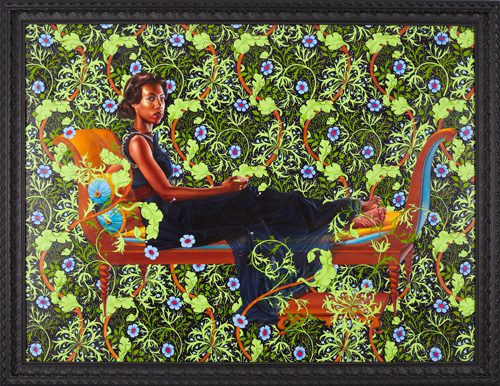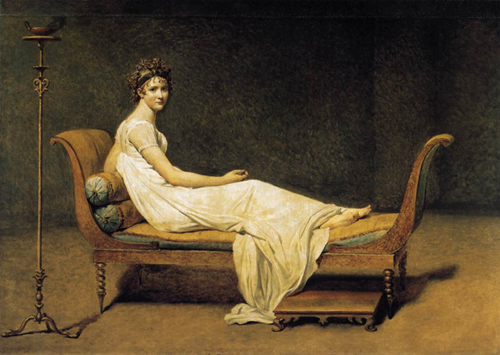
Kehinde Wiley, Juliette Recamier, 2012, Oil on linen, 72 inches x 96 inches quotes Jacques-Louis David's painting (see below)
On the heels of Black history month, I’d like to share some reflections about art history and introduce you to painter Kehinde Wiley.
While studying art history at university, one of the most eye-opening and explosive areas for me as a woman of colour, was investigating issues of race and identity in the works of artists of colour. Because we live in a world that’s become increasingly global and as we strive to connect with those from diverse cultures, I think it’s vital to understand some of the troubling issues they’ve been grappling with for centuries.
Although I ingested information about Black cultures in America and Africa through music, comedy shows and film, I never really understood their meaning until I took art history. Up until my early 30’s, I was in the dark with regards to the histories of Black peoples. If you read my blog post on my collage “Mrs. S” you’ll learn why. While I’d heard about Martin Luther King Jr. through a 1960’s pop song, I wondered why Black Americans continued to complain about equal access and rights in North American society. Like women, they’d received the right to vote; they’d been freed from slavery centuries before – what was still wrong in the mid 1990’s? Then I took Art and Feminism and Photography and Anthropology courses and they rocked my world. I couldn’t believe how derogatively people of colour, African peoples amongst them, had been treated by certain White cultures. I wept for many months reading their heart-breaking stories. I wondered why many Blacks hadn’t taken to violent means to set right their ill treatment throughout history. Instead, I was amazed to see so many become creative souls, taking up the pen, the brush and other creative means to help enlighten and heal themselves and the world. It was so inspiring.

Jacques-Louis David, Portrait of Juliette Recamier, Oil on canvas, 1800, 68.50 inches x 88.58 inches
For me, Black painter Kehinde Wiley is one such artist. He appeared to me almost as if in a dream… actually, while this insomniac was listening to late night radio. Through his art, Wiley asks: “Who I am in the world?” and “How do people who look like me fit into the broader cannon of art history?” An accomplished painter who studied his craft in St. Petersburg (the former Soviet Union), the San Francisco Art Institute and Yale, he hails from Los Angeles, California. His mom, a well-educated single-parent, sent her young sons to a free art program on the weekends to keep them off the streets during a time of unprecedented gang wars. Wiley excelled in art and continued his studies in the area of painting noting it made him feel special in the world. Now a highly respected American portrait painter his most well-known for body of work, “The World Stage”, depicts young Black men from America and around the world. In his latest series “An Economy of Grace” Wiley invited Black women from the streets of Harlem to participate in his latest portrait project. Attiring them in elegant designer Givenchy gowns he set them against ornate botanical backgrounds reminiscent of Art Nouveau or William Morris wallpaper designs. Positioning them in classical poses that mimic those used in the portraiture of high society European women throughout art history, the full effect of his compositional strategy gives the every day Black woman a feeling of great dignity perhaps denied to her in real life roles today and throughout history, art or otherwise. Portraying these women in such a distinguished fashion, Wiley bestows upon them a sense of empowerment and grace. The title of this series, “An Economy of Grace”, hints at the fact that Black women haven’t been paid the love and respect that they truly deserve from society. Throughout art history they’ve been stereotyped… eroticized as deviant sexual types or mammies. Wondering where women like the resilient, intelligent, resourceful Black women who raised him were, he set about remedying this situation through his portrait series. And, although Wiley has done portraits of famous sitters, this series that elevates and makes visible ordinary Black women seems close to his heart. Going beyond a visual critique, Wiley’s also auctioning off the gowns the women wore in these portraits to financially support their communities. On and off the canvas Kehinde Wiley’s a creative force to be reckoned with.
To learn more fascinating facts about Kehinde Wiley’s “An Economy of Grace” be sure to review the video link below where you’ll learn his method for choosing models off the streets; what makes his perfect model (you’ll be surprised); why he chose to portray the women in designer gowns and, most illuminating, more on the inspiration behind his title for the show… among other interesting reflections. He’s such an eloquent speaker!
Other Related Links:
Kehinde Wiley “Economy of Grace” Interview on CBC’s Q (February 2014)
Kehinde Wiley Website
The World Stage: Interactive Map (The Jewish Museum)
February 2012 Bits & Bytes: The Art of Wangechi Mutu
Please Note: I’ll be taking next weekend off. I’ll be back on March 16, 2014. Have a great week!

Leave a Reply